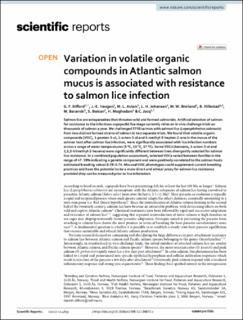Variation in volatile organic compounds in Atlantic salmon mucus is associated with resistance to salmon lice infection
Difford, Gareth Frank; Haugen, John-Erik; Aslam, Muhammad Luqman; Johansen, Lill-Heidi; Breiland, Mette Serine Wesmajervi; Hillestad, B.; Baranski, Matthew; Boison, Solomon Antwi; Moghadam, Hooman; Jacq, Celeste
Peer reviewed, Journal article
Published version
Permanent lenke
https://hdl.handle.net/11250/2988244Utgivelsesdato
2022Metadata
Vis full innførselSamlinger
- Artikler / Articles [1449]
- Publikasjoner fra CRIStin [2518]
Originalversjon
10.1038/s41598-022-08872-zSammendrag
Salmon lice are ectoparasites that threaten wild and farmed salmonids. Artificial selection of salmon for resistance to the infectious copepodid lice stage currently relies on in vivo challenge trials on thousands of salmon a year. We challenged 5750 salmon with salmon lice (Lepeophtheirus salmonis) from two distinct farmed strains of salmon in two separate trials. We found that volatile organic compounds (VOC), 1-penten-3-ol, 1-octen-3-ol and 6-methyl-5-hepten-2-one in the mucus of the salmon host after salmon lice infection, were significantly associated with lice infection numbers across a range of water temperatures (5 °C, 10 °C, 17 °C). Some VOCs (benzene, 1-octen-3-ol and 3,5,5-trimethyl-2-hexene) were significantly different between lines divergently selected for salmon lice resistance. In a combined population assessment, selected VOCs varied between families in the range of 47- 59% indicating a genetic component and were positively correlated to the salmon hosts estimated breeding values 0.59–0.74. Mucosal VOC phenotypes could supplement current breeding practices and have the potential to be a more direct and ethical proxy for salmon lice resistance provided they can be measured prior to lice infestation.
